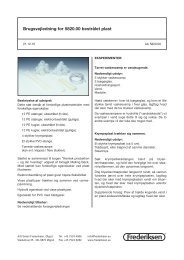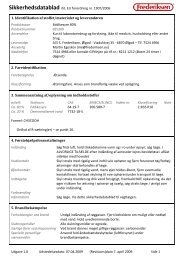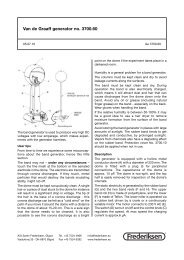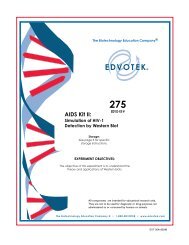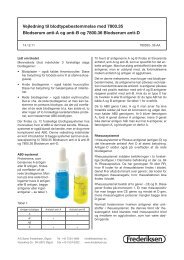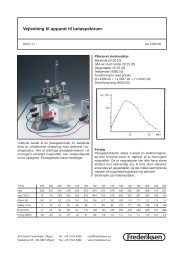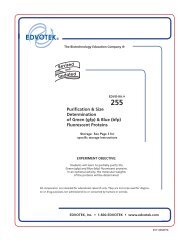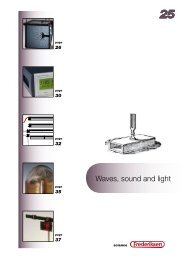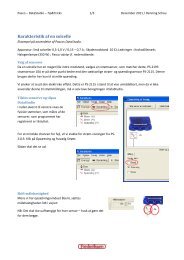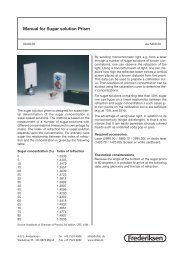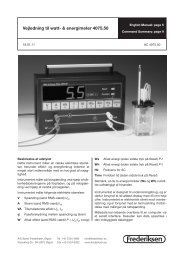PS-2149 - PASCO Scientific
PS-2149 - PASCO Scientific
PS-2149 - PASCO Scientific
Create successful ePaper yourself
Turn your PDF publications into a flip-book with our unique Google optimized e-Paper software.
Instruction Manual<br />
No. 012-08773A<br />
UVA Light Sensor<br />
Model <strong>PS</strong>-<strong>2149</strong><br />
<strong>PS</strong>-<strong>2149</strong><br />
UVA LIGHT<br />
collimator<br />
UVA filter and<br />
retaining cap<br />
UVA Light<br />
Sensor<br />
sensor<br />
handle<br />
Equipment Included<br />
Replacement Part<br />
UVA Light Sensor<br />
(Contact Tech Support)<br />
UVA Filter and retaining cap<br />
(Contact Tech Support)<br />
Collimator<br />
(Contact Tech Support)<br />
Sensor Handle<br />
CI-9874 (4-pack)<br />
Additional Equipment Required<br />
PASPORT interface<br />
DataStudio version 1.9 or higher<br />
Model Number<br />
(See <strong>PASCO</strong> catalog)<br />
(See <strong>PASCO</strong> catalog)
UVA Light Sensor<br />
Model No. <strong>PS</strong>-<strong>2149</strong><br />
Optional Accessories<br />
UVA Light Sensor Accessory Kit<br />
365nm Filter Accessory<br />
PASPORT Extension Cable<br />
Model Number<br />
CI-9792<br />
CI-9841<br />
<strong>PS</strong>-2500<br />
Introduction<br />
The <strong>PASCO</strong> <strong>PS</strong>-<strong>2149</strong> UVA Light Sensor is<br />
designed for use with a <strong>PASCO</strong> PASPORT<br />
interface to make measurements of relative<br />
electromagnetic radiation intensity in the UVA<br />
band.<br />
The sensing element of the UVA Light Sensor is<br />
a fairly broad-band Si photodiode. It is sensitive<br />
to electromagnetic energy ranging from visible<br />
light to above the UVA band. Since the radiation<br />
typically measured by the sensor is in the UVA<br />
band, the sensor is furnished with a UVA filter<br />
(UG-1 glass) that blocks light in the visible<br />
spectrum. You can remove the filter to make<br />
broader band measurements.<br />
The Ultraviolet (UV) radiation band extends<br />
from very short wavelengths of 100 nm, just<br />
below the x-ray band, to 400 nm, which is just<br />
above visible violet light. This can be observed<br />
in the table below.<br />
Ultraviolet Band (λ = 100–400 nm)<br />
vacuum UV UVC UVB UVA<br />
100–200 nm 200–280 nm 280–315 nm 315–400 nm<br />
far UV<br />
near UV<br />
The UV band is divided into four smaller bands<br />
according to the nature of the radiation. The<br />
shortest wavelengths are designated as the<br />
vacuum UV band (λ = 100–200 nm), so called<br />
because energy in this band can only be studied<br />
in a vacuum. Oxygen and other gas molecules in<br />
air absorb radiation in the vacuum UV band.<br />
The UVC band ranges from 200–280 nm.<br />
Essentially all UVC radiation from the sun is<br />
absorbed or scattered by ozone in the earth’s<br />
upper atmosphere and does not reach the<br />
surface.<br />
UVB radiation (λ = 280–315 nm) from the sun is<br />
also absorbed or scattered by the upper<br />
atmosphere but under some conditions it can<br />
reach the surface of the earth.<br />
Vacuum UV, UVC and UVB radiation have<br />
harmful, high-energy photons and can initiate<br />
chemical processes including changes in<br />
biological tissue called photo-biological<br />
reactions. Reaction-causing UV is also called<br />
actinic ultraviolet. It is characterized by photon<br />
energies above about 4 electron volts (eV). To<br />
compute the photon energy in eV from the<br />
wavelength in nanometers (nm), use this<br />
formula:<br />
E<br />
1240 eV ⋅ nm<br />
= ------------------------------ .<br />
λ<br />
For example radiation with a wavelength of 315<br />
nm has a photon energy of<br />
1240 eV ⋅ nm<br />
E = ------------------------------ ≈ 3.9 eV.<br />
315 nm<br />
UVA is the least hazardous ultraviolet radiation.<br />
Its band extends from 315–400 nm.<br />
It is worth noting that ordinary glass cuts off UV<br />
radiation with wavelengths of less than about<br />
300 nm. Thus UVA and some UVB can pass<br />
through glass.<br />
2 ®
Model No. <strong>PS</strong>-<strong>2149</strong><br />
UVA Light Sensor<br />
A UV light source is required to perform certain<br />
experiments and demonstrations with the UVA<br />
Light Sensor. The use of a source that radiates<br />
only in the UVA band is recommended because<br />
it is the least hazardous UV radiation. A small<br />
fluorescent “black” light makes a suitable UVA<br />
source.<br />
Other sources of UVA radiation are:<br />
• the sun (best on clear days - but some UV<br />
when overcast)<br />
• sun lamps for tanning<br />
• halogen lamps which are not “UV-protected”<br />
• fluorescent lamps<br />
the range that will cover the expected<br />
measurements without topping out.<br />
Using the Filter With Retaining Cap<br />
The UVA Light Sensor is shipped with the filter<br />
installed in the retaining cap. When the filter is<br />
removed from the retaining cap, the sensor can<br />
detect light in a wider range of wavelengths. To<br />
remove the filter, unscrew the retaining cap from<br />
the photodiode assembly. Be careful not to<br />
damage the filter.<br />
photodiode<br />
assembly<br />
<strong>PS</strong>-<strong>2149</strong><br />
UVA LIGHT<br />
Operation<br />
Setting up the Sensor<br />
Connect the UVA Light Sensor to the PASPORT<br />
interface. If you will use a computer, connect the<br />
PASPORT interface to the computer and launch<br />
DataStudio.<br />
Selecting the Gain Setting<br />
The sensor has three gain settings depicted by<br />
Candle, Lamp and Sun symbols. These symbols<br />
correspond to three ranges, which cover over 7<br />
orders of relative magnitude. The ranges, in<br />
relative units, and the approximate maximum<br />
(without filter) for each range are:<br />
Range<br />
Approx. Max.<br />
Candle 0–1 70 mW/m 2<br />
Lamp 0–100 7 W/m 2<br />
Sun 0–10 000 700 W/m 2<br />
The ranges are scaled so that a reading of 50 in<br />
the Lamp range will also be read as 50 in the Sun<br />
range. To ensure the maximum resolution, select<br />
retaining cap<br />
UVA filter<br />
1⁄4-20 threaded hole<br />
Using the Filter With the Collimator<br />
With the collimator installed, the sensor detects<br />
light only from sources in a narrow angle.<br />
Remove the retaining cap and replace it with the<br />
collimator.<br />
The filter is designed for use under conditions<br />
where there is not a significant amount of<br />
infrared radiation present; for instance, as part of<br />
a spectrometer. If it is necessary to filter out IR<br />
radiation, use the 365nm Filter Accessory<br />
(CI-9841).<br />
Mounting on an Experimental Apparatus<br />
The sensor handle screws into the 1⁄4-20<br />
threaded hole on the bottom of the sensor<br />
enclosure. You can use the sensor handle or any<br />
1⁄4-20 screw to secure the sensor to an<br />
experimental apparatus.<br />
®<br />
3
UVA Light Sensor<br />
Model No. <strong>PS</strong>-<strong>2149</strong><br />
Specifications<br />
sensing element<br />
filter<br />
spectral response<br />
gain levels<br />
PHOTO SENSITIVITY (A/W)<br />
0.3<br />
0.2<br />
0.1<br />
Si photodiode<br />
Schott UG-1 glass<br />
315–400 nm with<br />
UVA filter<br />
1x, 100x, 10 000x<br />
(Typ. Ta=25 °C)<br />
Technical Support<br />
For assistance with any <strong>PASCO</strong> product, contact<br />
<strong>PASCO</strong> at:<br />
Address: <strong>PASCO</strong> scientific<br />
10101 Foothills Blvd.<br />
Roseville, CA 95747-7100<br />
Phone: (916) 786-3800<br />
(800) 772-8700<br />
Fax: (916) 786-3292<br />
Web: www.pasco.com<br />
Email: techsupp@pasco.com<br />
Copyright and Warranty<br />
Information<br />
Copyright Notice<br />
0<br />
300 400 500 600 700 800 900 1000<br />
WAVELENGTH (nm)<br />
Spectral Response of Sensor (without filter)<br />
The <strong>PASCO</strong> scientific 012-08773A UVA Light<br />
Sensor Instruction Manual is copyrighted and all<br />
rights reserved. However, permission is granted<br />
to non-profit educational institutions for<br />
reproduction of any part of this manual,<br />
providing the reproductions are used only for<br />
their laboratories and are not sold for profit.<br />
Reproduction under any other circumstances,<br />
without the written consent of <strong>PASCO</strong> scientific,<br />
is prohibited.<br />
Limited Warranty<br />
For a description of the product warranty, see the<br />
<strong>PASCO</strong> catalog.<br />
UG-1 Filter Transmittance<br />
4 ®



